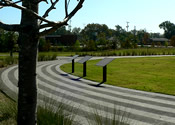Rain Inaugurates New Trail of Tears Park
A deluge of rain failed to stop a ceremony Tuesday, Oct. 12, to dedicate the newest piece of the UALR campus that restores and remembers — the Trail of Tears Park on the banks of Coleman Creek.
“Anytime we can create and preserve green space for our people, it is a moment to celebrate,” said Gov. Mike Beebe.
 The governor attended the dedication of the park that once was a collection of broken asphalt and unusable cement block buildings.
The governor attended the dedication of the park that once was a collection of broken asphalt and unusable cement block buildings.
Now it is a tranquil entrance to campus on the south and a tribute to the thousands of native people who stopped by the creek as they made their forced march to the west on the Trail of Tears.
“I feel the heartbeat and the footsteps of those who came through here,” said Sue Folsum, executive director of cultural events, historic preservation, and museums for the Choctaw Nation of Oklahoma.
Kirk Perry, administrator of the Division of Policies and Standards of the Chickasaw Nation, represented his tribal leaders at the dedication and welcomed the rain.
“It is a good day for Coleman Creek to get good water,” he said. “This is one small way to preserve a way of life.”
 The 4.5 acre park is near the site where thousands of Choctaw and Chickasaw people stopped for water on their way to Indian territories.
The 4.5 acre park is near the site where thousands of Choctaw and Chickasaw people stopped for water on their way to Indian territories.
It was known as the Trail of Tears, the federal government’s forced migration of native people to Indian lands in what is now Oklahoma and points west.
“Old maps show that the old Southwest Trail went through the intersection of Asher and University avenues,” said Dan Littlefield, director of UALR’s Sequoyah National Research Center.
“It was a resting place where they repaired their wagons and watered their horses. We have to use our imaginations to understand what they went through — it was one of the coldest winters of the time.”
The $650,000 donor-financed park project has restored the area to its natural state with native trees, rocks, and grasses.
 Chancellor Joel E. Anderson said the park project is the first in a community- and campus-planned rehabilitation of Coleman Creek. The project, described in UALR’s Master Plan, “On the Move,” calls for the creation of a 47-acre greenway reaching the full length of campus with lush vegetation, bicycle and walking trails, benches, and bridges.
Chancellor Joel E. Anderson said the park project is the first in a community- and campus-planned rehabilitation of Coleman Creek. The project, described in UALR’s Master Plan, “On the Move,” calls for the creation of a 47-acre greenway reaching the full length of campus with lush vegetation, bicycle and walking trails, benches, and bridges.
Landscape engineers believe the Trail of Tears Park and subsequent Coleman Creek Greenway will be the biggest project of de-urbanization in the history of Arkansas.
Ninety-year-old Janie Butler, whose grandmother’s house still stands diagonally from campus on Asher Avenue, attended the dedication. She celebrated the work that has been done to restore Coleman Creek, where she often swam as a girl.
“This is wonderful,” she said. “It’s going to be fun to get back to the creek.”